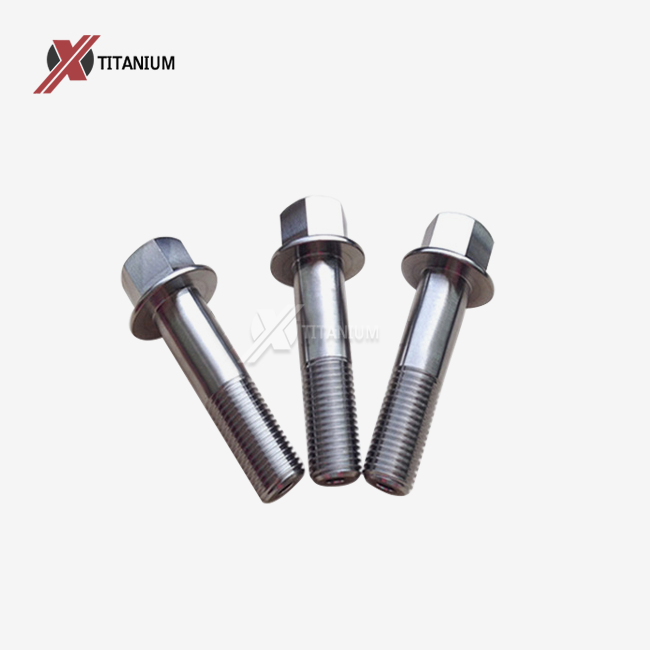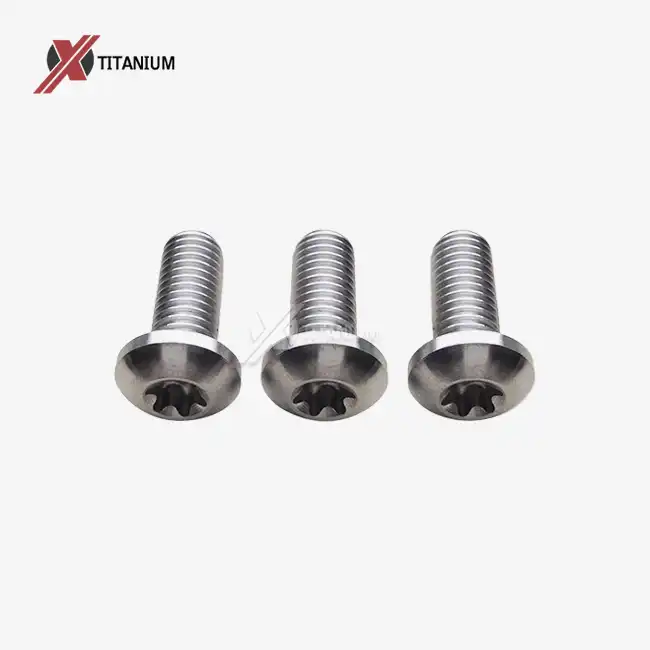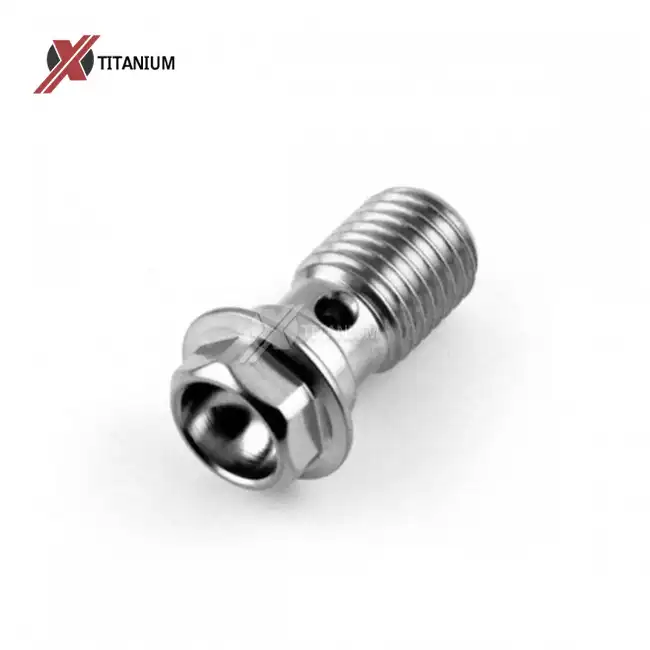Installing titanium flange bolts safely requires precise attention to detail and understanding of these specialized fasteners' unique properties. These lightweight yet incredibly strong components demand specific installation techniques to prevent damage and ensure optimal performance. Proper torque specifications, surface preparation, and sequential tightening patterns are essential for successful installation. The superior corrosion resistance and strength-to-weight ratio of titanium makes these bolts ideal for critical applications in aerospace, marine, and petrochemical industries. Understanding material compatibility, thermal expansion characteristics, and proper handling procedures ensures both installer safety and component integrity. This comprehensive guide explores proven methodologies for safe titanium flange bolt installation, drawing from industry standards and real-world expertise to help engineers and technicians achieve reliable, long-lasting connections.

Why Focus on Titanium Flange Bolt Installation Safety?
The aerospace and petrochemical industries increasingly rely on high-strength bolts due to their exceptional performance characteristics. Unlike conventional steel fasteners, titanium alloy bolts require specialized installation knowledge to prevent costly failures and safety incidents. These precision bolts operate in extreme environments where improper installation can lead to catastrophic consequences, making safety protocols absolutely critical.
Material costs for titanium fasteners significantly exceed traditional alternatives, making proper installation techniques essential for protecting investment value. The unique properties of Grade 5 titanium and Grade 2 titanium create specific challenges during installation, including different thermal expansion rates and galling susceptibility. Professional installation practices protect both personnel and equipment while maximizing the operational lifespan of these premium components.
Selection Criteria for Safe Installation Practices
Evaluating the most effective installation practices requires considering multiple performance factors. Installation safety depends on torque accuracy, surface preparation quality, thread compatibility, and environmental conditions. We assessed practices based on their ability to prevent galling, ensure consistent clamping force, and maintain long-term joint integrity.
The selection process prioritized methods that accommodate the unique characteristics of corrosion-resistant titanium flange bolts while meeting stringent industry standards like AS9100 and ASME B18.2.1. Each recommended practice underwent evaluation for its effectiveness across various applications, from aerospace bolts to marine bolts installations. Cost-effectiveness, training requirements, and equipment availability also influenced our recommendations for optimal installation procedures.
Seven Essential Titanium Flange Bolt Installation Practices
Proper Surface Preparation and Cleaning
Thorough surface preparation forms the foundation of safe installation for lightweight fasteners. Remove all contaminants, including oils, debris, and corrosion products from both bolt threads and receiving surfaces. Use appropriate solvents that won't react with titanium, avoiding chlorinated compounds that may cause stress corrosion cracking.
Clean surfaces using lint-free cloths and approved cleaning agents. Inspect threads for damage or foreign material that could cause cross-threading during installation. The exceptional corrosion resistance of titanium can be compromised by surface contamination, making meticulous cleaning essential. Establish clean room protocols when working with precision bolts destined for critical applications.
Surface roughness specifications must align with engineering requirements to ensure proper sealing and load distribution. Document cleaning procedures and maintain traceability records for quality assurance purposes. This attention to detail prevents installation problems and ensures optimal performance of these engineering bolts in demanding service conditions.
Anti-Seize Compound Application
Applying appropriate anti-seize compounds prevents galling during installation of titanium alloy bolts. Select compounds compatible with titanium that won't cause galvanic corrosion or contaminate sensitive systems. Silver-based or molybdenum disulfide compounds typically provide excellent protection without compromising joint integrity.
Apply anti-seize sparingly to male threads only, avoiding over-application that could affect torque readings. The compound should cover approximately 75% of the thread engagement length while preventing excess material from entering critical areas. Proper application techniques ensure consistent installation torque and facilitate future disassembly when required.
Document the specific anti-seize compound used for maintenance records and future service requirements. Different applications may require specialized compounds - medical applications need biocompatible materials while marine bolts require seawater-resistant formulations. Training personnel on proper application techniques prevents both under-application and contamination issues that could compromise joint performance.
Torque Specification Adherence
Accurate torque application ensures proper clamping force without exceeding the material's yield strength. Titanium's unique mechanical properties require specific torque values different from steel equivalents. Consult manufacturer specifications and industry standards like DIN6921 for precise torque requirements based on bolt diameter and grade.
Use calibrated torque wrenches appropriate for the required accuracy level, typically ±3% for critical applications. The relatively low elastic modulus of titanium compared to steel means these durable fasteners require careful attention to prevent over-torquing. Implement torque verification procedures using methods like tension indicating bolts or ultrasonic measurement when critical applications demand it.
Establish torque sequences for multi-bolt flanges that ensure even load distribution and prevent distortion. Star or cross-pattern tightening typically provides optimal results for circular patterns. Document actual torque values achieved during installation for quality records and future maintenance reference. Temperature effects on torque readings must be considered for installations in extreme environments.
Progressive Tightening Techniques
Progressive tightening prevents uneven loading and reduces stress concentrations around titanium flange bolts holes. Implement multiple-pass tightening sequences, starting at approximately 30% of final torque for the initial pass. This gradual approach allows materials to settle and accommodation thermal effects during installation.
Subsequent passes should increase torque in 25-30% increments until reaching final specification. This technique proves particularly important for heavy-duty bolts subject to high clamping loads. The progressive approach minimizes the risk of sudden load application that could damage threads or create stress risers in the titanium material.
Monitor bolt elongation during progressive tightening to verify proper loading. Visual inspection after each pass helps identify potential problems before they become critical. This methodical approach ensures threaded fasteners achieve optimal preload while maintaining safety margins throughout the installation process.
Thread Engagement Verification
Proper thread engagement ensures adequate strength and prevents premature failure of structural bolts. Minimum engagement should equal 1.5 times the bolt diameter for most applications, with critical aerospace applications often requiring greater engagement. Insufficient engagement can lead to thread stripping, while excessive engagement may cause installation difficulties.
Verify engagement length before applying full torque to prevent cross-threading or binding. The pitch accuracy of metric flange bolts and imperial threads must match precisely to ensure proper fit. Use thread gauges to verify compatibility and check for damage that could affect installation quality.
Document actual engagement measurements for quality records and future maintenance planning. Non-magnetic bolts used in sensitive electronic applications require particular attention to engagement verification since magnetic measurement tools cannot be used. Proper engagement ensures these custom bolts perform as designed throughout their service life.
Temperature Compensation Considerations
Temperature variations during installation affect torque readings and final clamping force. Titanium's coefficient of thermal expansion differs from steel, requiring compensation in mixed-material assemblies. Heat-resistant bolts must accommodate thermal cycling without losing preload or exceeding stress limits.
Install bolts at ambient temperature when possible to establish baseline conditions. For installations at elevated temperatures, adjust torque specifications according to manufacturer recommendations and thermal expansion calculations. The superior temperature stability of titanium provides advantages, but proper compensation ensures optimal performance.
Consider temperature effects on thread lubricants and anti-seize compounds during installation. Some compounds may lose effectiveness at extreme temperatures, requiring alternative materials for high-temperature applications. Document installation temperature conditions for future reference and maintenance planning.
Quality Inspection and Documentation
Comprehensive inspection protocols verify proper installation and provide traceability for automotive bolts and other critical applications. Visual inspection should identify any obvious defects, improper seating, or surface damage. Dimensional verification ensures bolts are properly seated and aligned according to engineering specifications.
Document all installation parameters including torque values, sequence, temperature, and any deviations from standard procedures. This documentation proves essential for quality assurance and future maintenance activities. Photographic records of completed installations provide valuable reference material for inspection and maintenance personnel.
Implement verification procedures appropriate to the application criticality. Non-destructive testing methods may be required for safety-critical installations in aerospace or medical applications. Proper documentation demonstrates compliance with quality standards and provides valuable data for continuous improvement initiatives.
Global Market Characteristics and Regulations
International standards govern industrial titanium flange bolts installation across different regions, with variations in requirements and certification processes. European markets typically emphasize DIN and EN standards, while North American applications follow ASME and ASTM specifications. Asian markets increasingly adopt international standards while maintaining some regional preferences.
Regulatory compliance varies significantly across industries, with aerospace and medical applications requiring the most stringent documentation and traceability. Environmental regulations in different regions affect material selection and disposal procedures for installation consumables. Understanding these variations ensures successful project execution in global markets.
Cultural preferences influence installation practices, with some regions emphasizing traditional methods while others readily adopt new technologies. Training and certification requirements vary by country, affecting workforce capabilities and project planning. Successful global operations require adaptation to local practices while maintaining consistent quality standards.
Purchasing Recommendations and Considerations
Source titanium fasteners from qualified suppliers with appropriate certifications and quality systems. Verify material certificates and dimensional compliance before accepting shipments. Establish supplier relationships based on technical capability rather than price alone, as premium materials require specialized knowledge and support.
Consider total cost of ownership including installation time, tool requirements, and maintenance needs. While initial costs exceed conventional alternatives, the superior performance and longevity of titanium often provide better value. Evaluate supplier capability to provide technical support and application guidance throughout the project lifecycle.
Maintain appropriate inventory levels while considering material shelf life and storage requirements. Establish clear specifications for surface treatments, coatings, and packaging to ensure materials arrive in optimal condition. Regular supplier audits help maintain quality standards and identify improvement opportunities.
Conclusion
Safe installation of titanium flange bolts requires understanding their unique properties and following proven procedures. Proper surface preparation, anti-seize application, and progressive torquing techniques ensure reliable performance and personnel safety. Temperature compensation and quality documentation complete the installation process while providing traceability for future maintenance. The investment in proper installation techniques pays dividends through improved reliability, reduced maintenance costs, and enhanced safety margins. These practices enable engineers and technicians to harness the full potential of titanium fasteners while maintaining the highest safety standards across diverse industrial applications.
Frequently Asked Questions
Q1: What torque specifications should I use for titanium flange bolts?
A: Torque specifications depend on bolt diameter, grade, and application requirements. Generally, titanium bolts require 15-20% lower torque than equivalent steel bolts due to different material properties. Always consult manufacturer specifications and relevant standards like DIN6921 or ASME B18.2.1 for precise values.
Q2: Can I reuse titanium flange bolts after removal?
A: Titanium bolts can often be reused if properly inspected for thread damage, elongation, and surface condition. However, critical applications may require new bolts for each installation. Non-destructive testing methods can verify bolt condition when reuse is being considered.
Q3: What anti-seize compounds work best with titanium bolts?
A: Silver-based or molybdenum disulfide compounds typically provide excellent protection without causing galvanic corrosion. Avoid copper-based compounds that may cause galvanic reactions. For medical applications, use biocompatible compounds that meet regulatory requirements.
Partner with Chuanglian for Premium Titanium Flange Bolt Solutions
Chuanglian delivers exceptional titanium flange bolts that meet the most demanding installation requirements across global markets. Our comprehensive product line includes Grade 2 and Grade 5 titanium options with various surface treatments including polishing, anodizing, and nitriding. Located in Baoji City, known as the "City of Titanium," we leverage over ten years of experience in titanium products machining and research.
Our state-of-the-art CNC machine tools and mechanical processing equipment ensure precision manufacturing that meets international standards including DIN6921 and ASME B18.2.1. We maintain strict quality control systems from raw materials through finished products, with every production step carefully inspected. Our AS9100, ISO9001, and medical certifications demonstrate our commitment to quality excellence.
As a leading titanium flange bolts manufacturer, we provide comprehensive technical support to help customers select optimal materials and installation procedures. Our engineering team assists with application-specific requirements, ensuring successful project outcomes. We offer customized solutions including various diameters from M3 to M30, multiple thread types, and specialized coatings to meet unique application needs.
Ready to enhance your projects with premium titanium fasteners? Contact our technical experts to discuss your specific requirements and receive personalized recommendations. Our global supply chain ensures reliable delivery schedules that meet your project timelines. Reach out to us today to experience the Chuanglian advantage - contact us at info@cltifastener.com or djy6580@aliyun.com for immediate assistance with your titanium flange bolt requirements.
References
1. American Society of Mechanical Engineers. "ASME B18.2.1 Standard for Square and Hex Bolts and Screws" - Engineering standards publication covering dimensional specifications and installation requirements for hex bolts including titanium variants.
2. Deutsches Institut für Normung. "DIN 6921 Hexagon Head Bolts with Flange" - German engineering standard defining specifications for flanged hex bolts including material requirements and installation guidelines.
3. Aerospace Industries Association. "AS9100 Quality Management Systems for Aerospace" - Quality management standard covering requirements for titanium fastener manufacturing and installation in aerospace applications.
4. International Titanium Association. "Titanium Fastener Design and Application Guidelines" - Technical publication providing comprehensive guidance on titanium bolt selection, installation procedures, and performance characteristics.
5. ASTM International. "ASTM F467 Standard Specification for Nonferrous Nuts for Use with Bolts for High Temperature or High Pressure Service" - Material standard covering titanium fastener specifications and testing requirements for critical applications.
6. Society of Automotive Engineers. "SAE ARP 1228 Titanium and Titanium Alloy Fasteners" - Aerospace recommended practice document detailing installation procedures and quality requirements for titanium fasteners in aircraft applications.



